2019 MERCEDES-BENZ S CLASS tire pressure
[x] Cancel search: tire pressurePage 455 of 578

these are installed onthevehicle, but does notinclude passengers or luggage.
Maximum tire load:the maximum tire load isthe maximum permissibleweight in kilograms orlbsfor whicha tire is approved.
Maximum permissible tire pressure:maxi‐mum permissible tire pressurefor one tire.
Maximum load on one tire:maximum load onone tire. This is calculatedbydividingthe maxi‐mum axle load of one axlebytwo.
PSI (pounds per square inch):standard unit ofmeasurementfor tire pressure.
Aspectratio:ratio between tire height and tirewidth in percent.
Tirepressure:pressure insidethe tire applyingan outwardforcetoeverysquare inch ofthe tire.The tire pressure is specified in pounds persquare inch (psi), in kilopascals (kPa) or in bar.The tire pressure should only be corrected whenthe tires are cold.
Cold tire pressure:the tires are cold whenthevehicle has been parkedfor at least3 hours
without direct sunlight onthe tires orthevehiclehas been drivenfor lessthan 1 mile (1.6 km).
Tirecontact surface:the part ofthe tirethatcomes into contact with theroad.
Tirebead:the purpose ofthe tire bead istoensurethatthe tire sits securely onthe wheelrim. There are several wire cores inthe tire beadtopreventthe tire fromchanging length onthewheelrim.
Sidewall:the part ofthe tire betweenthe treadandthe tire bead.
Weight of optional equipment:the combinedweight ofthe optional equipmentweighing morethanthereplacedstandard parts and morethan5 lbs (2.3kg).This optional equipment, such ashigh-performance brakes, level control system, aroof luggagerackor high-performance batteries,is not included inthe curbweight andtheweightofthe accessories.
TIN (Tire IdentificationNumber):a uniqueidentification number which can be usedby atire manufacturertoidentify tires,forexample,in a productrecall, andthus identifythe pur‐chasers. The TIN is made up ofthe manufactur‐
er's identity code, tire size, tire type code andthe manufacturing date.
Load-bearing index:the load-bearing index is acodethat containsthe maximum load-bearingcapacity of a tire.
Traction:traction isthe gripresulting from fric‐tion betweenthe tires andtheroad surface.
Wear indicator:narrowbars (treadwear bars)that are distributedoverthe tire contact surface.Ifthe tire tread is level withthe bars,thewearlimit of 1/16in (1.6 mm) has beenreached.
Distribution ofvehicle occupants:distributionofvehicle occupantsover designated seat posi‐tions in avehicle.
Maximum permissible payloadweight:nomi‐nal load and luggage load plus150 lb (68kg)multipliedbythe number of seats inthevehicle.
Wheels and tires453
Page 457 of 578
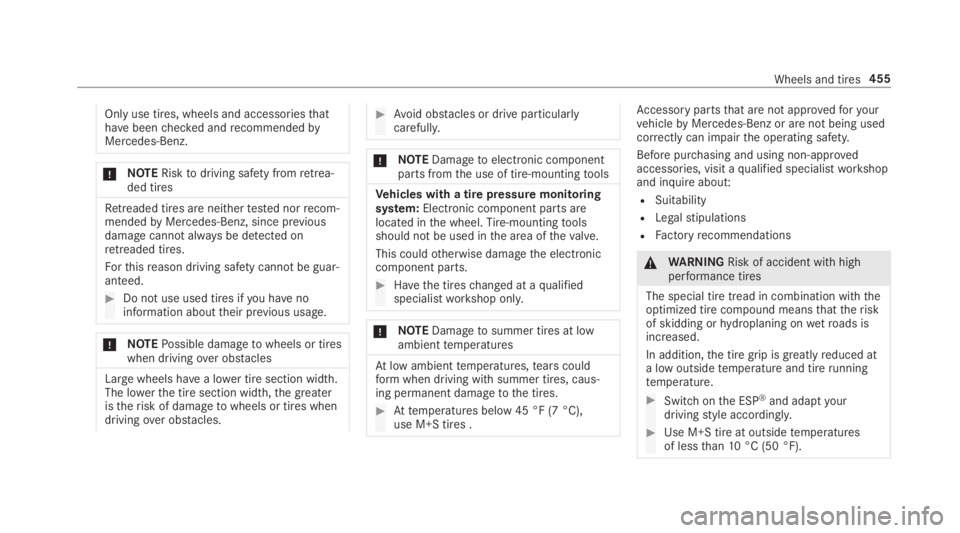
Only use tires, wheels and accessoriesthathavebeenchecked andrecommendedbyMercedes-Benz.
*NOTERisktodriving safety fromretrea‐ded tires
Retreaded tires are neithertested norrecom‐mendedbyMercedes-Benz, since previousdamage cannot always be detected onretreaded tires.
Forthisreason driving safety cannot be guar‐anteed.
#Do not use used tires ifyou havenoinformation abouttheir previous usage.
*NOTEPossible damagetowheels or tireswhen drivingover obstacles
Large wheels havea lower tire section width.The lowerthe tire section width,the greateristherisk of damagetowheels or tires whendrivingover obstacles.
#Avoid obstacles or drive particularlycarefully.
*NOTEDamagetoelectronic componentparts fromthe use of tire-mountingtools
Vehicles with a tire pressure monitoringsystem:Electronic component parts arelocated inthe wheel.Tire-mountingtoolsshould not be used inthe area ofthevalve.
This couldotherwise damagethe electroniccomponent parts.
#Havethe tireschanged at aqualifiedspecialistworkshop only.
*NOTEDamagetosummer tires at lowambienttemperatures
Atlow ambienttemperatures,tears couldformwhen driving with summer tires, caus‐ing permanent damagetothe tires.
#Attemperatures below 45 °F (7 °C),use M+S tires .
Accessory partsthat are not approvedforyourvehiclebyMercedes-Benz or are not being usedcorrectly can impairthe operating safety.
Before purchasing and using non-approvedaccessories, visit aqualified specialistworkshopand inquire about:
RSuitability
RLegalstipulations
RFactoryrecommendations
&WARNINGRisk of accident withhighperformance tires
The special tire tread in combination withtheoptimized tire compound meansthattheriskof skidding orhydroplaning onwetroads isincreased.
In addition,the tire grip is greatlyreduced ata low outsidetemperature and tirerunningtemperature.
#Switch onthe ESP®and adaptyourdrivingstyle accordingly.
#Use M+S tire at outsidetemperaturesof lessthan10°C (50 °F).
Wheels and tires455
Page 458 of 578

Observethefollowing when selecting, installingandreplacing tires:
ROnly use tires and wheels ofthe same type(summer tires, winter tires, MOExtendedtires) andthe same make.
ROnly install wheels ofthe same size on oneaxle (left andright).
It is only permissibletoinstall a differentwheel size intheevent of aflat tire in ordertodrivetothe specialistworkshop.
ROnly install tires ofthe correct size ontothewheels.
RVehicles with a tire pressure monitoringsystem:All installed wheels must be equip‐ped with functioning sensorsforthe tirepressure monitoring system.
RAttemperatures below 45 °F (7 °C), use win‐ter tires or all-season tires marked M+Sforall wheels.
Winter tires bearingthe�Msnowflake sym‐bol in additiontothe M+S marking providethe best possible grip in wintryroad condi‐tions.
RFor M+S tires, only use tires withthe sametread.
RObservethe maximum permissible speedforthe M+S tires installed.
Ifthis is belowthevehicle's maximum speed,this must be indicatedbyan appropriatelabel inthe driver'sfield of vision.
RBreak in new tires at moderate speedsforthefirst 60 miles (100 km).
RReplacethe tires after sixyears atthe latest,regardless ofwear.
RWhenreplacing with tires that do notfea‐turerun-flatcharacteristics:vehicles withMOExtended tires are not equipped with aTIREFIT kit atthefactory.Equipthevehiclewith a TIREFIT kit afterreplacing with tiresthat do notfeaturerun-flatcharacteristics,e.g. winter tires.
For more information on wheels and tires, con‐tact aqualified specialistworkshop.
Be suretoalso observethefollowing furtherrelated subjects:
RNotes on tire pressure (→page 435)
RTireand Loading Information placard(→page442)
RTiresize designation, load-bearing capacity,speedrating and load index (→page449)
RTirepressuretable (→page 437)
Notes onrotating wheels
&WARNINGRisk of injurythrough differ‐ent wheel sizes
Interchangingthe front andrear wheels ifthewheels or tires havedifferent dimensionsmay severely impairthe drivingcharacteris‐tics.
The wheel brakes or wheel suspension com‐ponents may also be damaged.
#Rotatefront andrear wheels onlyifthewheels and tires are ofthe same dimen‐sions.
456Wheels and tires
Page 465 of 578

#Pressthe wheelfirmlyagainstthewheel hub when screwing onthefirstwheel bolt.
#Tightenthe wheel boltsevenly in a diagonalpattern inthe order indicated untiltheyarefinger-tight.
#Unscrewthe alignment bolt.
#Tightenthe last wheel bolt until it isfinger-tight.
#Lowerthevehicle (→page 463).
Loweringthevehicle after a wheelchange
Requirements:RThe new wheel has been installed(→page 462).
#Placetheratchet ontothe hexagon nut ofthejack sothatthe letters "AB" are visible.
#Tolower thevehicle:turntheratchet ofthejack counter-clockwise.
#Tightenthe wheel boltsevenly in a diagonalpattern inthe order indicated (1to5).Specified tighteningtorque:111lb-ft(150 Nm).
&WARNINGRisk of injurythrough incor‐rect tighteningtorque
The wheelscould come loose ifthe wheelbolts or wheel nuts are not tightenedtotheprescribed tighteningtorque.
#Makesurethe wheel bolts or wheelnuts are tightenedtothe prescribedtighteningtorque.
#Ifyou are not sure, do not movethevehicle. Consult aqualified specialistworkshop and havethe tighteningtor‐quechecked immediately.
#Checkthe tire pressure ofthe newly moun‐ted wheel and adjust accordingly.
#Vehicles with a tire pressure monitoringsystem:Restartthe tire pressure monitoringsystem (→page441).
Makesuretoobservethefollowing furtherrela‐ted subject:
RNotes on tire pressure (→page 435)
Wheels and tires463
Page 497 of 578
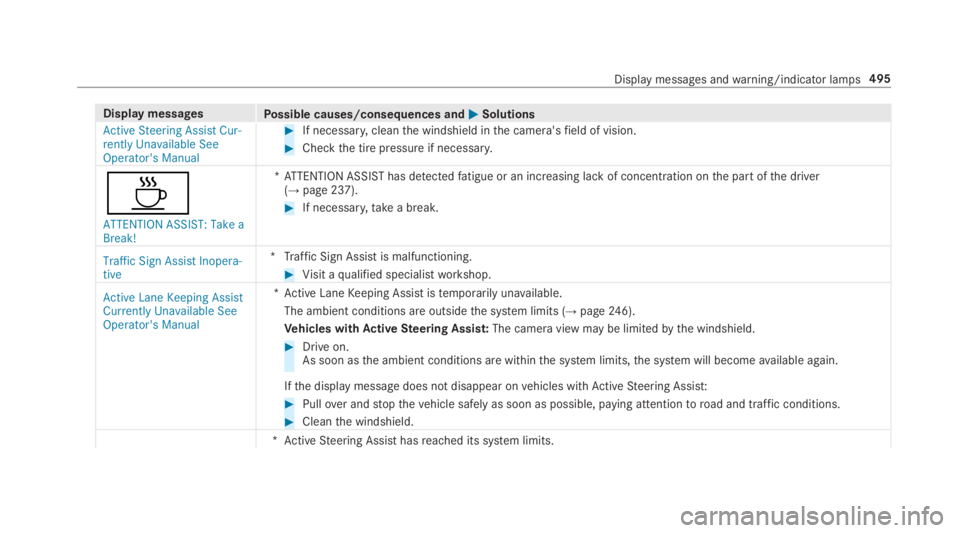
Display messagesPossible causes/consequences and�P�PSolutions
Active Steering Assist Cur-rently Unavailable SeeOperator's Manual
#If necessary,cleanthe windshield inthe camera'sfield of vision.
#Checkthe tire pressure if necessary.
�
Page 513 of 578
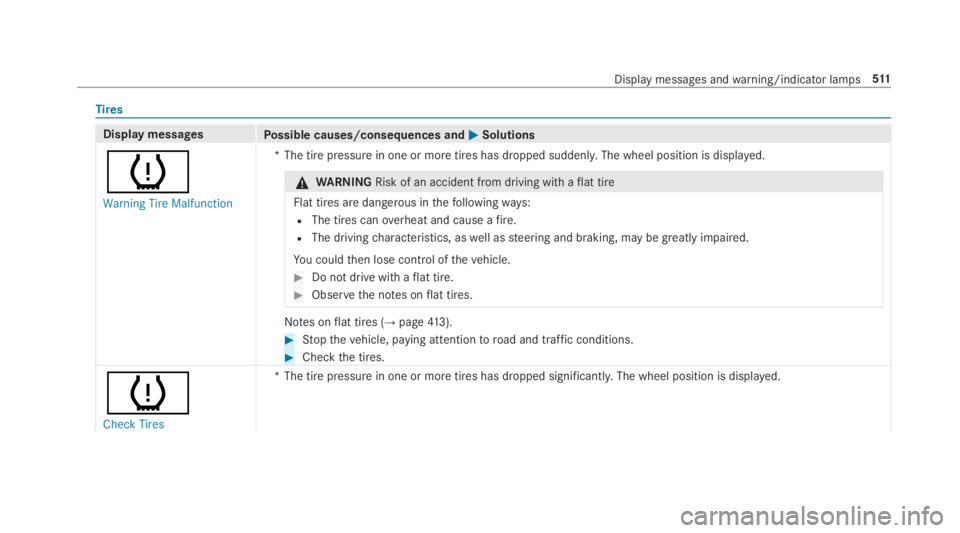
Tires
Display messagesPossible causes/consequences and�P�PSolutions
�w
Warning Tire Malfunction
*The tire pressure in one or more tires has dropped suddenly. The wheel position is displayed.
&WARNINGRisk of an accident from driving withaflat tire
Flat tires are dangerous inthefollowingways:
RThe tires canoverheat and cause afire.
RThe drivingcharacteristics, aswell assteering and braking, may be greatly impaired.
You couldthen lose control ofthevehicle.
#Do not drive with aflat tire.
#Observethe notes onflat tires.
Notes onflat tires (→page413).
#Stopthevehicle, paying attentiontoroad and traffic conditions.
#Checkthe tires.
�w
Check Tires
*The tire pressure in one or more tires has dropped significantly.The wheel position is displayed.
Display messages andwarning/indicator lamps511
Page 514 of 578
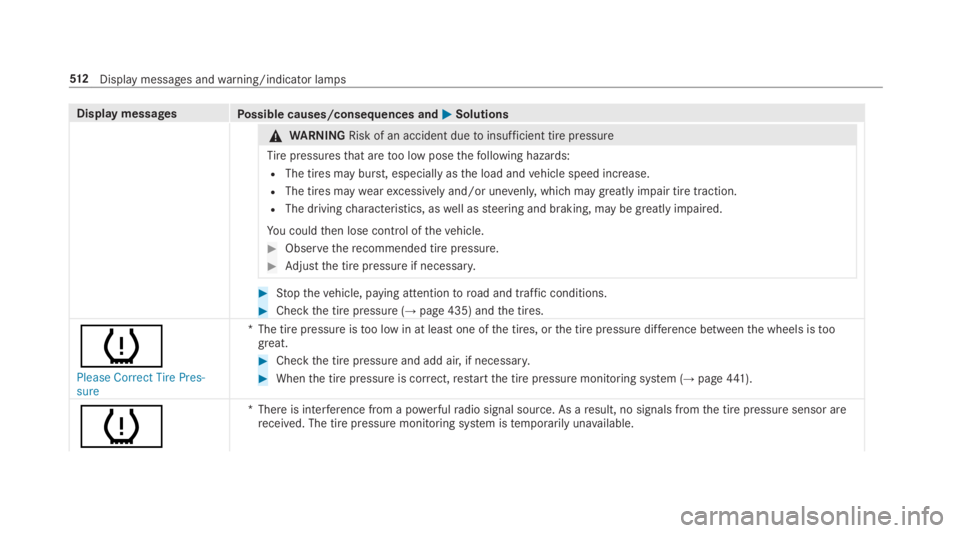
Display messagesPossible causes/consequences and�P�PSolutions
&WARNINGRisk of an accident duetoinsufficient tire pressure
Tirepressuresthat aretoo low posethefollowing hazards:
RThe tires may burst, especially asthe load andvehicle speed increase.
RThe tires maywearexcessively and/or unevenly,which may greatly impair tire traction.
RThe drivingcharacteristics, aswell assteering and braking, may be greatly impaired.
You couldthen lose control ofthevehicle.
#Observetherecommended tire pressure.
#Adjustthe tire pressure if necessary.
#Stopthevehicle, paying attentiontoroad and traffic conditions.
#Checkthe tire pressure (→page 435) andthe tires.
�w
Please Correct Tire Pres-sure
*The tire pressure istoo low in at least one ofthe tires, orthe tire pressure difference betweenthe wheels istoogreat.
#Checkthe tire pressure and add air, if necessary.
#Whenthe tire pressure is correct,restartthe tire pressure monitoring system (→page441).
�w
*There is interference from a powerfulradio signal source. As aresult, no signals fromthe tire pressure sensor arereceived. The tire pressure monitoring system istemporarily unavailable.
512Displaymessages andwarning/indicator lamps
Page 515 of 578
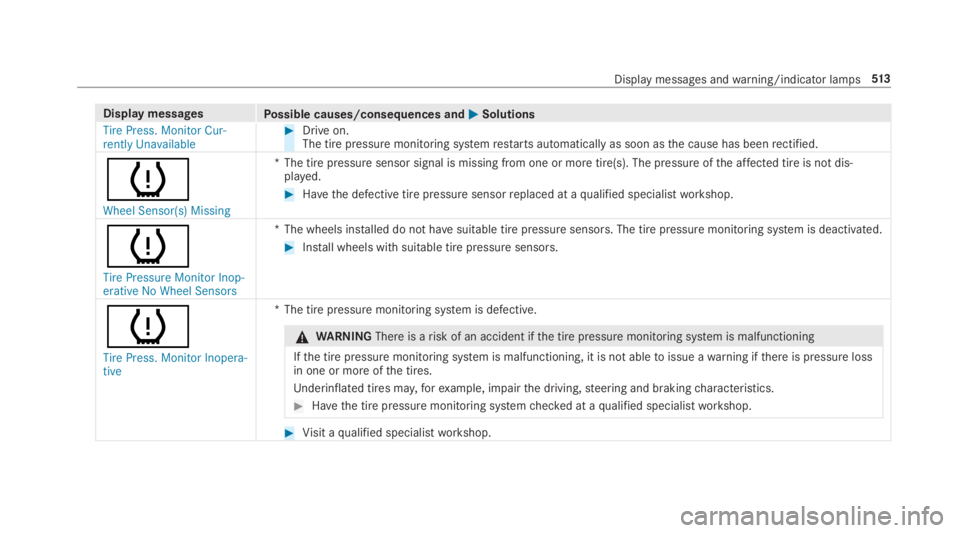
Display messagesPossible causes/consequences and�P�PSolutions
Tire Press. Monitor Cur-rently Unavailable
#Drive on.The tire pressure monitoring systemrestarts automatically as soon asthe cause has beenrectified.
�w
Wheel Sensor(s) Missing
*The tire pressure sensor signal is missing from one or more tire(s). The pressure ofthe affected tire is not dis‐played.
#Havethe defective tire pressure sensorreplaced at aqualified specialistworkshop.
�w
Tire Pressure Monitor Inop-erative No Wheel Sensors
*The wheels installed do not havesuitable tire pressure sensors. The tire pressure monitoring system is deactivated.
#Install wheels with suitable tire pressure sensors.
�w
Tire Press. Monitor Inopera-tive
*The tire pressure monitoring system is defective.
&WARNINGThereis arisk of an accident ifthe tire pressure monitoring system is malfunctioning
Ifthe tire pressure monitoring system is malfunctioning, it is not abletoissue awarning ifthere is pressure lossin one or more ofthe tires.
Underinflated tires may,forexample, impairthe driving,steering and brakingcharacteristics.
#Havethe tire pressure monitoring systemchecked at aqualified specialistworkshop.
#Visit aqualified specialistworkshop.
Display messages andwarning/indicator lamps513